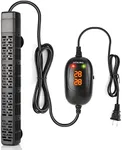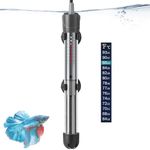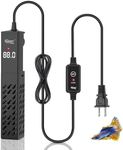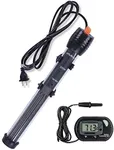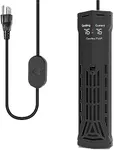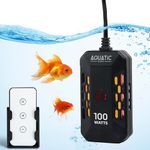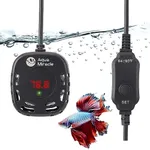Buying Guide for the Best Aquarium Heaters
Choosing the right aquarium heater is crucial for maintaining a stable and healthy environment for your aquatic pets. The heater ensures that the water temperature remains within a suitable range for the species you are keeping, which is essential for their well-being and survival. When selecting an aquarium heater, you need to consider several key specifications to ensure it meets the needs of your aquarium setup and the specific requirements of your fish or other aquatic creatures.WattageWattage refers to the power output of the heater and determines how effectively it can heat the water in your aquarium. The general rule of thumb is to have 3-5 watts per gallon of water. For example, a 50-gallon tank would typically require a heater with 150-250 watts. If you have a larger tank, you may need a higher wattage heater or multiple heaters to distribute the heat evenly. For smaller tanks, a lower wattage heater will suffice. Consider the size of your tank and the ambient room temperature when choosing the wattage to ensure your heater can maintain the desired temperature.
Type of HeaterThere are several types of aquarium heaters, including submersible, immersible, in-line, and substrate heaters. Submersible heaters are placed entirely underwater and are the most common type, offering even heating and easy installation. Immersible heaters hang on the side of the tank and are partially submerged, but they are less efficient and more prone to damage. In-line heaters are installed in the filtration system and are ideal for larger tanks or those with complex setups. Substrate heaters are placed under the tank's substrate and are often used in planted tanks to promote root growth. Choose the type that best fits your tank setup and maintenance preferences.
Temperature ControlTemperature control refers to the ability to set and maintain a specific temperature within the aquarium. Heaters with adjustable thermostats allow you to set the desired temperature, which is crucial for species that require precise temperature ranges. Some heaters come with built-in thermostats, while others may require an external controller. Look for heaters with accurate and reliable temperature control to ensure the safety and comfort of your aquatic pets. If you have species with specific temperature needs, an adjustable heater is essential.
Size and ShapeThe size and shape of the heater should be compatible with your aquarium. Heaters come in various lengths and shapes, so it's important to choose one that fits well within your tank without obstructing decorations or the swimming space of your fish. For smaller tanks, a compact heater is ideal, while larger tanks may require longer or multiple heaters to ensure even heat distribution. Consider the layout of your tank and where you plan to place the heater when making your selection.
Durability and Safety FeaturesDurability and safety features are important to ensure the longevity of the heater and the safety of your aquatic pets. Look for heaters made from high-quality, shatterproof materials that can withstand the aquatic environment. Safety features such as automatic shut-off, overheat protection, and indicator lights can prevent accidents and ensure the heater operates safely. These features are especially important if you have a busy household or if the heater will be left unattended for extended periods.
